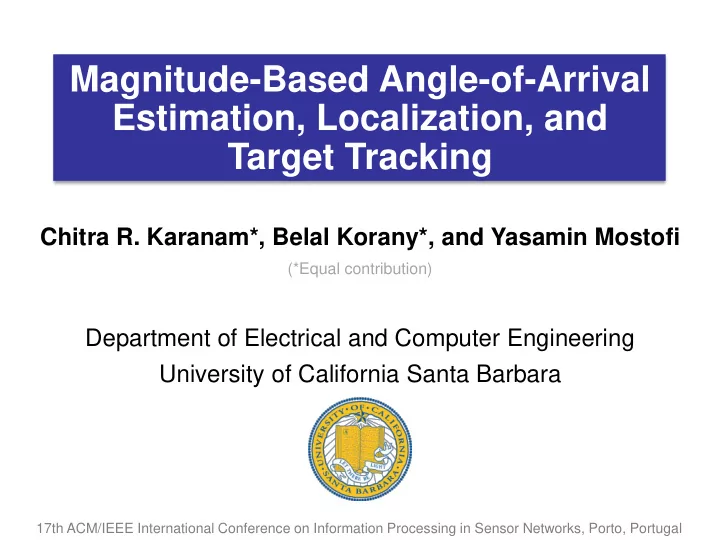

Magnitude-Based Angle-of-Arrival Estimation, Localization, and Target Tracking Chitra R. Karanam*, Belal Korany*, and Yasamin Mostofi (*Equal contribution) Department of Electrical and Computer Engineering University of California Santa Barbara 17th ACM/IEEE International Conference on Information Processing in Sensor Networks, Porto, Portugal
Angle-of-Arrival Estimation • Important traditional problem with established solutions - Several applications - Beamforming, MUSIC, ESPRIT • Requires signal phase measurements at receiver array - Needs synchronization across antennas - Difficult to measure on off-the-shelf devices 2
Magnitude-Based AoA Estimation Signal magnitude plot Estimate of AoAs Magnitude/power – easily measurable on off-the-shelf devices Estimate angle-of-arrival with only signal magnitude 3
Localization and Tracking Source localization Target tracking Crowd counting and spatial behavior Sensor network localization 4
Outline • Magnitude-Based AoA Estimation - Show it possible to extract AoA information from power spectral density of receptions - Extensive experiments: Angular localization of active and passive sources • Magnitude-Based Target Tracking - Duality between AoA estimation and target tracking - A new framework for target tracking with a very small number of transceivers - Extensive experiments: Active and passive target tracking • Conclusions 5
Outline • Magnitude-Based AoA Estimation - Show it possible to extract AoA information from power spectral density of receptions - Extensive experiments: Angular localization of active and passive sources • Magnitude-Based Target Tracking - Duality between AoA estimation and target tracking - A new framework for target tracking with a very small number of transceivers - Extensive experiments: Active and passive target tracking • Conclusions 6
Magnitude-Based Framework • The complex baseband received signal as a function of Phase at 1 st antenna Path amplitude • Power spectral density from spatial autocorrelation function of Constants Total power 7
AoA Estimation Spectrum of autocorrelation Peaks in spectrum are located at Obtain Problem: Given , estimate Equivalent to placing points on a line, given the pairwise distances Ambiguities: Mirroring, translation, translation + mirroring, other ambiguities Solution: Place a reference source at a known angle 8
AoA Estimation Framework – Algorithm and Example Algorithm: 0 0.3 0.7 1 0.4 0.6 0 0.7 1 0.4 0.6 0 0.3 1 0.4 0.6 0 1 0.6 0 1 0.4 0.7 0 0.4 1 • Add reference source at 0 0.3 1 0.6 • Let the actual be • Terminate: Solutions are sets with pairwise distance set How do we resolve remaining ambiguity? 9
AoA Estimation Framework – An Example (cont.) • Estimate angles for Route 2 • With , we get • Subtracting 30° from , we get • Comparing with AoA result 10
Special Case: Dominant Reference Source • Revisiting power spectral density • For a dominant reference source, • Therefore, unknown AoAs can be measured directly as Set of peaks in the spectrum 11
Experimental Results – Active Source AoA Estimation Experiment areas Experiment details: WiFi 802.11n measurements Transmitter: TP-Link AC1750 router Receiver: Intel 5300 WiFi NIC True and estimated angles True AoAs Estimated AoAs {66.42 ∘ , 120 ∘ } {67.74 ∘ , 120.22 ∘ } {66.42 ∘ , 120 ∘ } {66.14 ∘ , 120.29 ∘ } {66.42, ∘ 120 ∘ , 143.1 ∘ } {65.99 ∘ , 117.4 ∘ , 140.72 ∘ } {90 ∘ , 120 ∘ } {90.43 ∘ , 117.57 ∘ } 𝟐. 𝟒 ∘ MAE 12
Experimental Results – Passive Source AoA Estimation Experiment areas Experiment details: WiFi 802.11n measurements Transmitter: TP-Link AC1750 router Receiver: Intel 5300 WiFi NIC True and estimated angles True AoAs Estimated AoAs {90 ∘ , 120 ∘ } {92.38 ∘ , 124.2 ∘ } {90, ∘ 110 ∘ } {89.14 ∘ , 111.4 ∘ } {45 ∘ , 90 ∘ } {42.18 ∘ , 80.14 ∘ } {45 ∘ , 69 ∘ , 90 ∘ } {46.68 ∘ , 64.88 ∘ , 86.66 ∘ } {90 ∘ , 110 ∘ } {89.14 ∘ , 111.4 ∘ } 𝟑. 𝟘𝟘 ∘ MAE 13
Target Tracking Framework Active moving target • For a single moving active target Phase at 𝑢 = 0 Direct signal from Tx fix • Comparing with the AoA estimation model, Passive moving target • Hence, we can measure • Similarly, for a moving passive target 14
Ambiguity in Tracking • Consider a moving active target • Momentarily assume knowledge of location Measurement of at one Rx Measurement of at two Rxs Need to incorporate motion dynamics to resolve the remaining ambiguity 15
Particle Filter for Tracking • receivers located at Tracking simulation with PF • Fixed transmitter located at • State at time • Measurement process at time • A constant-speed motion model for dynamics of • Measurement equation relates to state 16
Experimental Results – Active Target Tracking Tracking result – Route U Experiment area 8 m x 8 m area WiFi 802.11n transceivers MAE = 𝟒𝟏. 𝟕 cm 17
Experimental Results – Tracking a Passive Robot Experiment areas 8 m x 8 m area 8 m x 8 m area Tracking results MAE = 𝟑𝟒. 𝟑𝟖 cm 18
Experimental Results – Human Tracking Tracking result Experiment area MAE = 𝟒𝟏. 𝟑𝟕 cm 19
Comparison with State-of-the-Art • AoA estimation - Existing approaches need phase - Comparing case of active sources: ▪ Our approach achieves MAE of 1.76° ▪ Typical phase-based approaches achieve comparable MAE of 0.93° • Target tracking - Several existing methods require phase, complex transceivers - Magnitude-only approaches typically need several transceivers and/or high computation and/or extensive calibrations. 20
Conclusions • New framework for magnitude-based AoA estimation - Using spectral content of autocorrelation of signal magnitude - Angular localization of active and passive sources - MAE of 2.44° over all the experiments • Target tracking - Duality of AoA framework - Nonlinear dynamical system modeling and particle filter - Using only three receivers and one transmitter - Decimeter-level target tracking of active and passive targets 21
Thank you! This work is funded by NSF CCSS award # 1611254 22
Recommend
More recommend